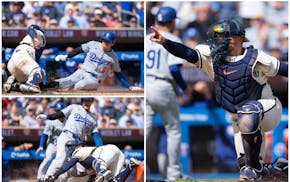Joel Maturi ran the Gophers athletic department for a decade. He encountered his share of financial challenges and turbulent moments but nothing that compares to the harsh realities caused by this pandemic. He can't imagine being athletic director under current conditions.
"It's one of the good reasons for being old," he joked of retirement.
Like many, he's concerned about the state of college athletics and the financial implications from lost revenue, especially if this crisis lasts long enough to impact the football season. That would be a significant problem because football keeps many departments afloat financially.
Maturi's legacy as AD is that he championed Olympic, nonrevenue sports. He worries about the fate of those sports as departments everywhere — from Power Five conferences to Division III schools — deal with massive revenue loss.
"I don't know any AD who wants to cut sports," he said. "[But] you have to look at every option that's available to you."
COVID-19 will change the way college sports operate. That's not debatable at this point. Just like with every industry and occupation in America. The only question is the degree to which change happens.
The Gophers revealed a glimpse of their predicament Tuesday at a Board of Regents meeting. Even the most optimistic outlook is sobering.
The school estimates that the athletic department in a best-case scenario stands to lose $10 million in revenue. What the board deems as a "moderate" forecast — athletic competitions start again in the fall without fans in attendance — would create expected revenue loss of $30 million. That figure would jump to $75 million under a severe scenario in which the pandemic causes a shutdown that extends into next year.
A $10 million hit from a $130 million budget is painful. Revenue loss that goes significantly higher would be damaging.
Now consider that the Gophers are in far better shape than many athletic departments that don't have the financial benefit of being in a power conference supported by its own television network and cable partnerships.
Gophers athletic director Mark Coyle, his senior staff and some coaches are taking voluntary pay cuts, mirroring a recent decision by Iowa State AD Jamie Pollard, who instituted cuts for his staff and coaches to save $3 million in payroll.
The guess here is that Coyle will ask all his head coaches to accept pay reductions in what likely will become a common cost-saving measure in athletic departments around the country.
That won't be enough though, even in best-case scenarios. Athletic departments face tough decisions in figuring out how to operate with less money. Staff sizing, travel restrictions and other budget trims are logical options.
Those decisions will become even more difficult if the pandemic affects football, specifically its attendance. Will fans still feel the desire to cram into stadiums this fall, even if life has returned to some semblance of normalcy in terms of being able to leave the house for more than essential tasks?
College football is the cash cow. For departments to function as they did pre-pandemic, football revenue needs to remain robust through ticket sales and media rights. It's impossible to predict how quickly the economy will rebound and what impact that might have on corporate sponsorships, donations, ticket buying, suite rentals and so on.
So many questions that can't be answered, but it's not hard to predict a deceleration of the arms race — at least for the foreseeable future — that has transformed college sports over the past two decades.
TV contracts have pumped billions into college sports, allowing athletic departments to continuously up the ante in facilities, salaries, staffing and infrastructure. The Gophers' 2018-19 budget shows they reeled in $43.7 million in media rights revenue, including their share of Big Ten Network profits, in one school year alone.
The bar never settles in one spot. It just gets keep getting raised higher and higher, so schools are always chasing to keep pace. The have-nots chase the haves. The haves chase the have-mores.
Coaching salaries and athletic budgets now compared to a decade ago are a different ballgame. This crisis will create a new reality for schools.
"College sports as we know it will not be the same," Maturi said.
That statement wasn't meant as hyperbole, more matter of fact. The entire world has changed. College sports are no different. How different is yet to be determined but it likely will be substantial.

Scoggins: Worried about costly trade up in draft for QB? Vikings bosses shouldn't be.
Scoggins: 'Wait one more year' can't be the Wild's plan. Thankfully, it isn't.

Scoggins: Finch feeling heat of the Suns as playoff battle looms
Scoggins: Why 'championship or bust' fits these Wolves


